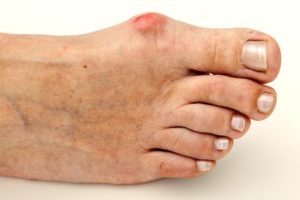Medically known as Hallux Abducto Valgus (HAV), the term ‘bunion’ describes a bony bulge that can develop over time on the inside of the big toe. The bulge is caused by a malaligned position of the big toe joint where the long bone (metatarsal) moves out towards the other foot and the connecting toe (phalanx) bends in on it, toward the other toes. Bunions tend to progressively worsen in ‘stages’ and become more prominent. As they do, the ligaments and tissues surrounding the joint stretch and contract accordingly, ultimately leaving the joint in a fixed position. Bony and arthritic changes can also occur within the joint. This means that bunions have different characteristics at different stages and the right management needs to be decided on a case-by-case basis.
Causes of bunions are numerous and vary greatly. Anything that squeezes or puts greater pressure and force through the big toe joint, like pointed shoes, may be a potential contributing factor. Often bunions can run in the family, are more prevalent in women than men, and are thought to be linked with an unstable function at the big toe joint. Other contributing factors include:

The biggest sign is the change in appearance (protrusion) of the big toe joint. You may also experience:
As the bunion progressively worsens, the big toe may push into the lesser toes. Over time, the toes may begin to overlap.
As bunions progressively worsen over time, starting treatment early is the key! If you’ve started noticing your bunion developing either recently or within the last couple of years, now is the best time to take action.We start by identifying the extent of the changes in the big toe joint. A treatment plan can then be implemented to reduce symptoms and limit future progression. Biomechanical and alignment issues will be identified. Periodic evaluation and x-rays may be advised or in some cases observation of the bunion is sufficient. Depending on the characteristics of your bunion, you may benefit from some of the following:
As bunions are often associated with other foot problems, treatment will also address any underlying issues that are identified. If the symptoms or the deformation is not reducible, surgery may be indicated.

We’ve all had those days — you come home after hours on your feet, kick off your shoes, and notice your ankles look puffier than usual.
Swelling in the feet, ankles, or legs (known medically as edema) isn’t always a reason to panic. It can be as simple as a
salty lunch or a long flight.
But what if it’s happening more often — or seems to be getting worse? Swelling can sometimes be a sign of something more serious. Here’s
what could be going on and when to check in with your doctor.
.jpg)
Every year on October 8th, the world celebrates International Podiatry Day - a day dedicated to
raising awareness about foot health and the vital role that podiatrists play in our overall well-being.

There’s been a lot of buzz about going barefoot. Some say it helps strengthen feet and improves performance, while others warn it can do more harm than good. The truth? It depends on the person, the surface, and how it’s done.
Keeping your family on their feet and helping them to walk, run, play and exceed their goals is why we love getting up in the morning.
Ground Floor, One Health Building
122 Remuera Rd, Remuera
Auckland 1050, New Zealand
| MON - FRI | 7:30am – 6:30pm |
| SAT | 8:30am – 4:30pm |
| SUN | Some availability |
Make an Appointment
Online Schedule
Our virtual receptionist is available 24/7 to help with general questions, booking requests, and clinic information, even when our team is busy, or it's after hours.
Whether you're calling us or using our website, you'll get fast assistance any time of day. And if your query needs a personal touch, a member of our team will follow up as soon as possible.
If you’d like to see a podiatrist who speaks your preferred language, just give us a call and we’ll help you book.